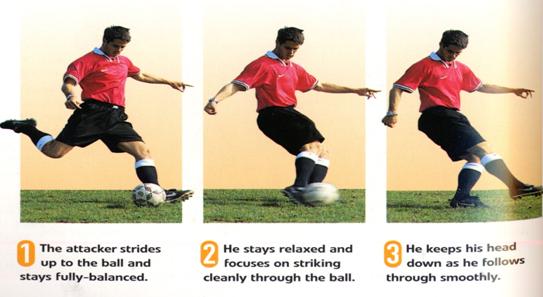

Ball Control
Ball Control
There are three important points for good ball control:
- The first touch should protect the ball from challenging players and not give them a chance to regain possession.
- The ball should be played into available space to allow for the next touch.
The ball should be played so that the team’s movement or momentum is continued.
132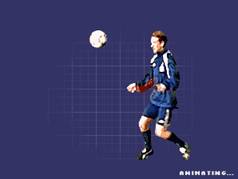
You always hear how important a good first touch is in getting the ball under control. |
improve your ball control step 1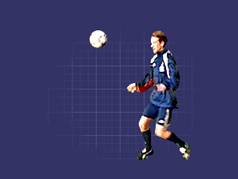 Get into line with the flight of the ball as quickly as you can and decide how you are going to control the ball. Work on practicing your control with your feet, thigh, chest or head, as you can receive the ball at any height. Trying to control a ball above waist height with your feet is not an easy skill, so why risk it when you can use your chest? |
Improve your ball control step 2 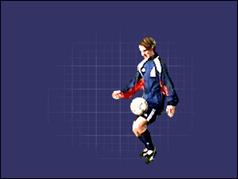 Present the area of your body that you want to control the ball with - your thigh for example. Get as large an area behind the ball as you can. If you are controlling the ball with your thigh then get the full face of it in line with the ball. |
Improve your ball control step 3 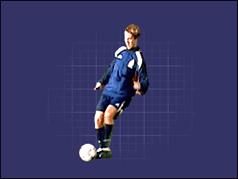 As you make contact with the ball, try to relax the surface area, such as your thigh. This will help you cushion the ball. It will then hopefully drop to the ground and you can then pass the ball or shoot, depending on where you are. |
Ball control with the feet:
- Practice controlling the ball by having a friend pass to you or by hitting the ball against a wall.
- Use different parts of your foot to stop the ball and nudge it in front of you, ready to play on.
- To take the pace off the ball and bring it fully under control, let the ball come to you – don’t push at it.
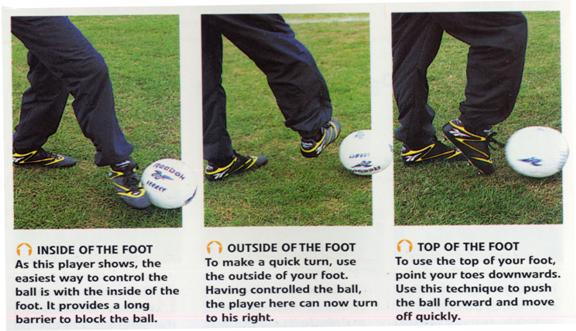
Dribbling
Another important aspect of ball control is the ability to run with the ball.The key coaching points are:
- Use short steps.
- Push the ball forward gently with the inside or the outside of the foot. Alternate feet.
- Keep the ball close and in front.
- Use peripheral vision (that is, the ‘corner’ of the eye) to look at the ball while watching the direction being travelled. As skill increases, look less at the ball.
- Monitor speed based on ability to keep the ball close.
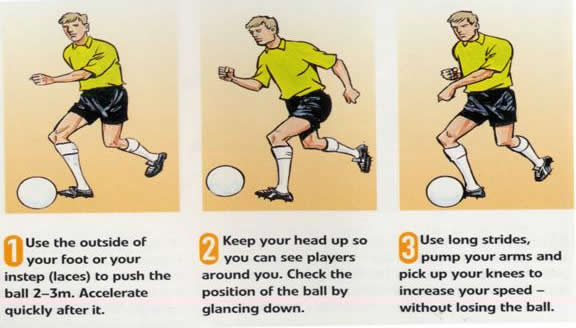
- You can practice this skill by yourself in a park. It simply a case of running 30m or so with the ball at your feet.
- At first, you should concentrate on keeping the ball under control.
- Then, work on increasing your speed, whilst still maintaining good control.
- If you can get some friends to be defenders, it will be an even more rewarding exercise. The defenders can put pressure on the player running with ball.
Passing
Successful passing is the key to good teamwork. Teaching the technique of passing is actually quite straightforward but it is not always easy to spot and remedy the mistakes that children make.The key coaching points are:
- Use inside of the foot (the instep).
- The non-striking foot should be pointing in the direction of the intended target.
- The striking leg makes a swinging motion similar to a putter in golf.
- The striking ankle must be locked.
- Stay relaxed. Don’t be like a robot.
- Look up to find your target but remember to look at the ball as you strike it. That is the only way the player can strike the ball correctly.
- Foot follows through in direction of target.
Move afterwards – don’t stand there admiring your pass!
Short passing:
12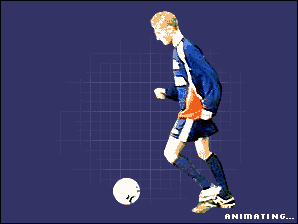 Passing quickly gets the ball upfield and reduces the risk of giving away possession. The sidefoot (inside of the foot) provides the greatest accuracy for passing. But it is difficult to generate power and it is also easy for an opponent to see where you are intending to pass the ball. For those reasons, it is best to use this skill just for short passes. |
short passing step 1 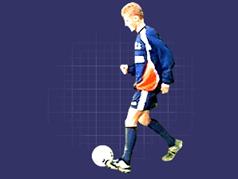 Ideally, you want to approach the ball at an angle of about 30 degrees so that you have room to swing your kicking leg through. Get your non-kicking foot close to the side of the ball, use your arms for balance and keep your head still and eyes on the ball. |
short passing step 2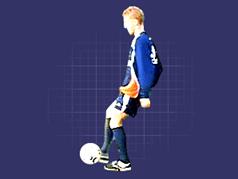 Keeping your ankle firm, bring your kicking foot through and strike the centre of the ball (to keep it on the ground) with the side of the foot. With this type of passing you are looking to keep the ball low so that it is easy for a team-mate to control. |
short passing step 3 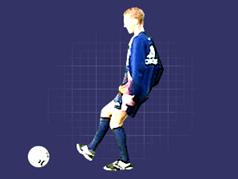 The weight you put on the pass is also critical. Follow through with the kicking leg to increase power, but the weight of the pass will depend on how far away your team-mate and opposition players are. You will become increasingly better at judging this the more you play. |
Bending the ball:
123 < <Football is a team game . Playing as a team requires each player to be able to pass the ball well. Make eye contact with the intended receiver. This is the starting point for successful passing. |
step 1 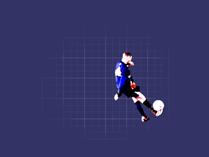 Position your standing foot a comfortable distance from the ball as you approach at an angle. Start by practising this skill for a dead ball situation such as a free-kick. But you also want to have the ability of curling a shot or pass from open play when you are on the move. |
step 2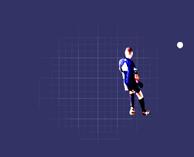 To curve the ball from right to left use the inside of your foot, striking the bottom half of the right side of the ball. Or if you want to curve the ball from left to right with your right foot, use the outside of your foot. Aim to make contact with the bottom half of the left side of the ball. In both cases your followthrough will not be in the direction of the target as you are cutting across the back of the ball rather than kicking through the centre of it. |
Drive passing (low pass):
To make a low pass with enough strength to get past an opponent, you must use the instep and drive through the ball. It can split a defense, and keeping the ball on the ground will make it easy for a team-mate to run on to.
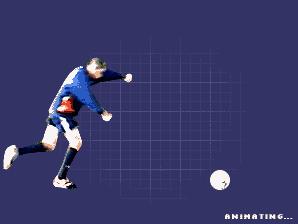
step 1 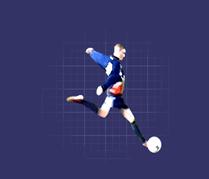 The approach to the ball is the same as with the short sidefoot pass. Approach the ball at an angle of about 30 degrees so that you have room to swing your kicking leg through. Position your non-kicking foot close to the side of the ball, use your arms for balance and keep your head still and eyes on the ball.
|
step 2 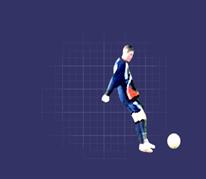 To keep the ball low, you must concentrate on keeping your knee over the ball, and remember not to lean back. Strike the centre of the ball with the laces (instep), with the toes pointing downwards. |
step 3 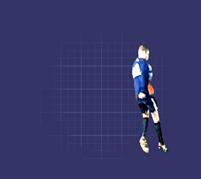 Follow through with the kicking leg to increase power. |
Push the pass:
- For passes of up to 25m or so, the push pass is most accurate. Plant your standing foot beside the ball and strike it in the middle with the inside of your foot, so that it rolls to the receiver.
- Make sure you follow through in the same direction as the pass.
- Note that with this technique, you will not get as much leverage to drive the ball powerfully over long distance.
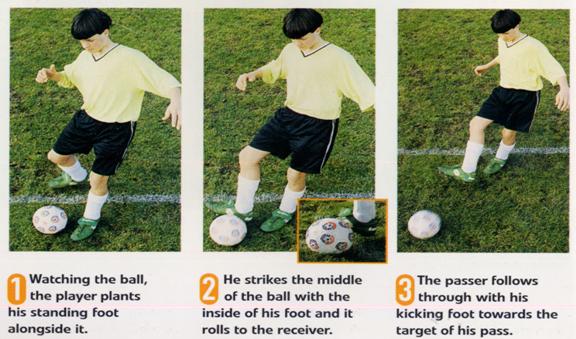
Shooting:
To score goals, players need to be able to use both power and placement.The key coaching points are:
- Keep the head down and eyes on the ball – look up to pick out the target, but then look back at the ball to shoot.
- Plant non-striking foot alongside (not in front of) the ball.
- Strike the middle of the ball so it doesn’t rise.
- Keep the knee of the kicking leg over the ball.
- Approach the ball slightly from the side.
- Follow through, don’t jerk back when striking the ball (loses power).
Shooting tips 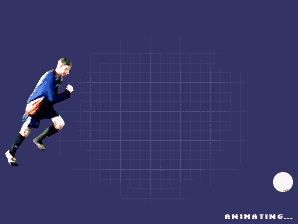 Scoring goals is what football is all about - and it's easily the most glamorous and rewarding part of the game. To be a great goal scorer, you've got to be able to shoot. Sounds obvious, but how easy is it? |
step 1  Power and accuracy are the main principles of shooting. Aim to drive the ball low with the instep of your foot. To increase power, bring the kicking leg through quickly and increase your follow-through. |
step 2  Aim to get plenty of power into the shot, but don't sacrifice accuracy. If a shot isn't on target it doesn't matter how hard you hit - it will just take you a bit longer to get the ball back. |
The long-range shot:
- First practice kicking a stationary ball about 20 yards from goal.
- Don’t try to hit the ball too hard – you’ll lose your balance and the shot could end up anywhere.
- Take a full stride up to the ball and concentrate on hitting through it cleanly and keeping the shot down. Controlled power is the key to long-range shooting. Eventually try to start aiming for the corners of the goal to make life difficult for the keeper.
